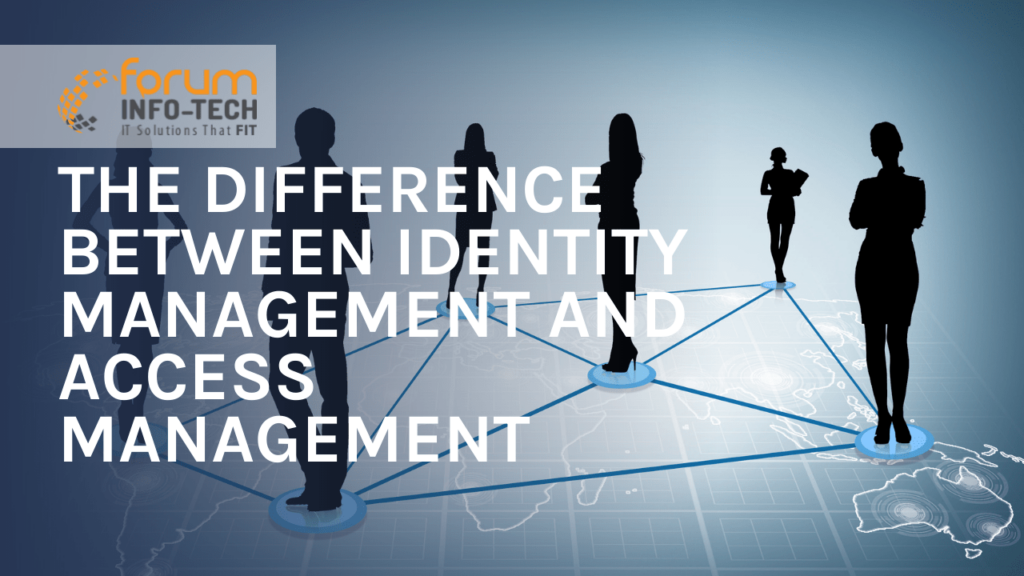People are often confused about the difference between identity management and access management. Even though they sound similar, both of these terms depict different levels of cybersecurity.
To put it simply, with identity management, you manage the attributes of a user. While with access management, you manage access allowed to a user based on their attributes. Or, identity management is when you authenticate users, and access management is when you authorize users.
People often use authentication and authorization interchangeably too, but the truth is that they serve entirely different purposes. Authentication is simply the process of telling ‘who’ you are. And it takes place when a person logs in through a login portal. At the same time, authorization is when a person is authorized to access a certain resource.

Everyone has an identity in the digital world. These identities are differentiated based on the attributes of each user in the database. When someone registers online, they plug in much different information about themselves. Employers also assign additional attributes to their employees, like mentioning the business unit or project they are part of, their title in the company, or their status in the organization’s hierarchy.
Unlike social media, these identities are verified, genuine, and sometimes stored in the database even after an employee retires or resigns. Each person in the database has only a single well-managed digital identity through identity and access management.
Let’s look at what both these terms mean.
What is Identity Management
Identity management is the management of your digital identity. When you work for an organization in the digital arena, you have a few attributes assigned to you. These attributes can be things like your designation, department, and job requirements. It’s the attributes in the database that give you a unique characteristic. These attributes are usually managed by the company’s IT and HR personnel.
Identity management includes creating, maintaining, and checking these digital identities and attributes of the employees. Through identity management, you can also manage an employee’s data as the years pass. For example, when an employee gets a promotion, shifts to a different project, or even get married, these all lead to changes in their attributes.
Identity management allows the right people to have the right amount of access at the right time. It is incredibly crucial to have the correct identity management for your company because that later translates into access to your company’s resources and data.
What is Access Management
Like the name itself spells out, access management authorizes a user to access or not access specific company data or resources. It is a yes or no decision that is made based on the attributes of the user. Access management is required when an employee either wants to log in or use some resource.
There can be more than one access point. Depending on the attributes, a user isn’t allowed to enter or view the resource. But, there can also be instances where the user is denied access to a specific document or file in the folder. The access points for access management can be on login portals or pages.
When users log in (authenticates), their attributes are delivered and then checked for access (authorization). If you are trying to authorize a resource, you first need to be authentic about who you are. However, as stated earlier, authentication identifies the user while authorization checks if a user deserves access to the resource or not.
Different people in the company get different access levels depending on their rank, role, and job. All of this is managed through IAM (identity and access management). Access management requires regular maintenance and monitoring of the employees’ identities to keep their changing needs in check.
Thus, access management lets you control or restrict company resource authorization based on an employee’s digital identity.
Final Thoughts
Identity and access management are different levels of security. These security checks are now more critical with employees working across time zones than ever. These security checks and authorizations are also crucial for the company if many suppliers, third-party vendors, etc. Identity and access management is also important to keep your company’s data safe from getting hacked, stolen, or manipulated.
To sum it up, identity and access management are essential for cybersecurity. Businesses and companies need to be sure that the right person is authenticated and authorized to the right resource at the right time. With identity management, a company manages a user profile based on the user’s attributes. And, with access management, the decision to authorize or access the resources is provided. Identity and access management (IAM) altogether control and monitor all authorization, authentication, and control access.

